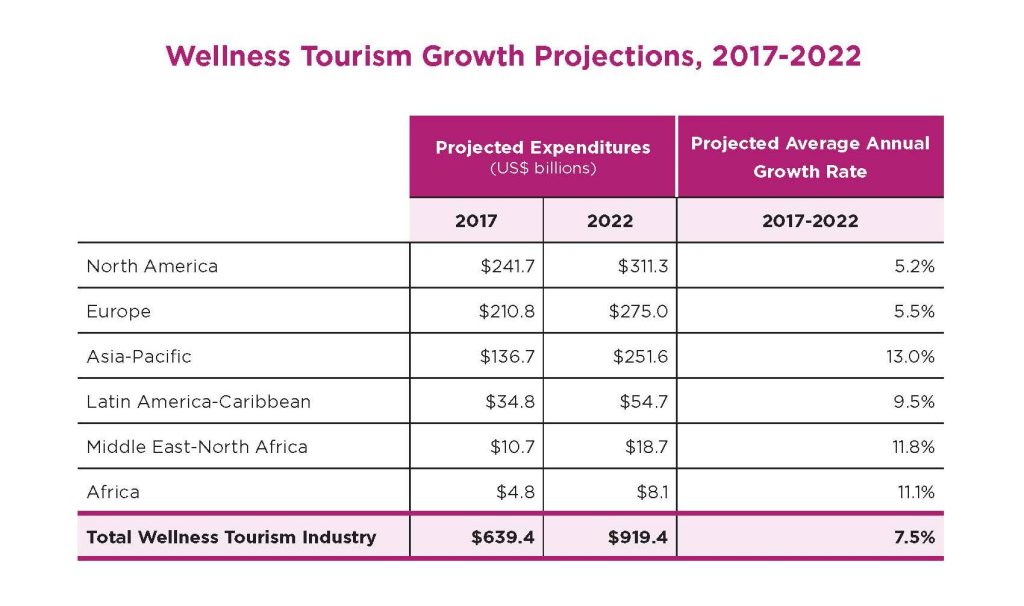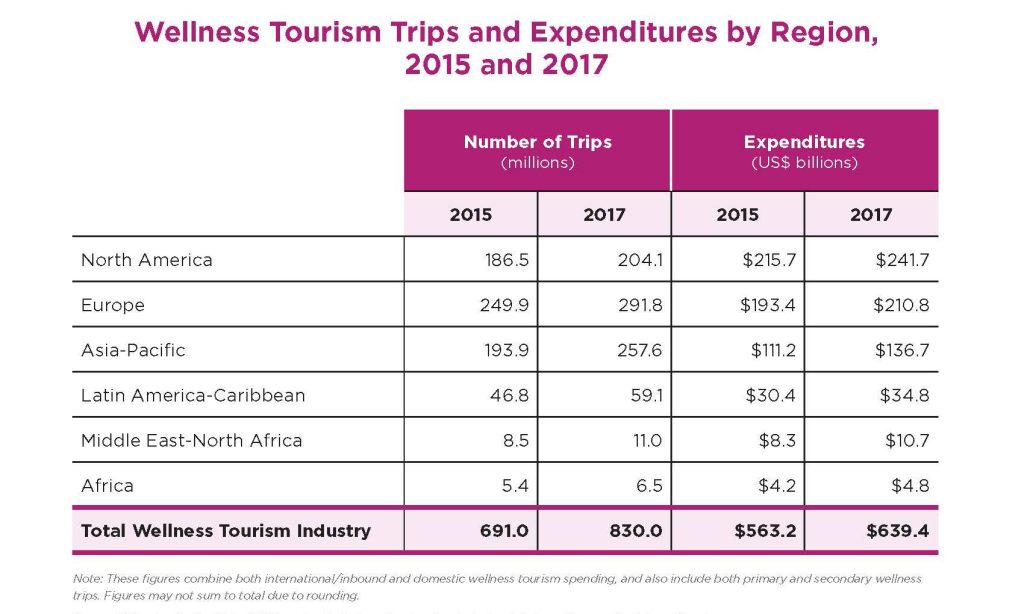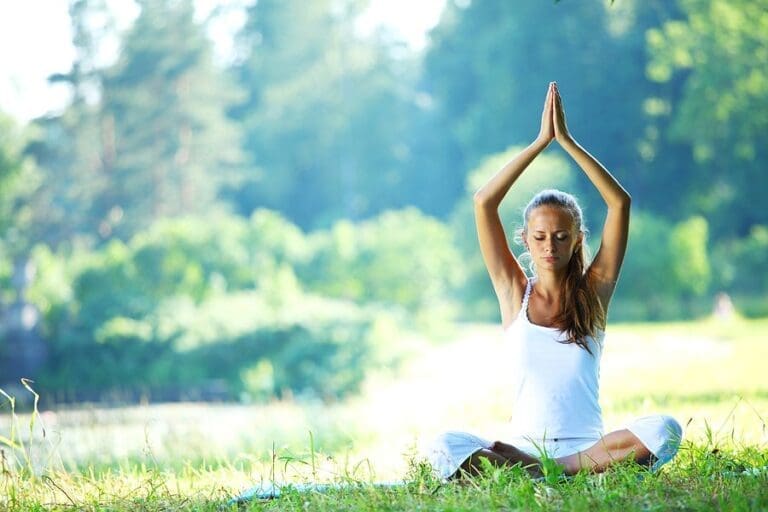 Wellness tourism grew from a $563 billion market in 2015 to $639 billion in 2017, or 6.5 per cent annually, more than twice as fast as tourism overall (3.2 per cent ).*
Wellness tourism grew from a $563 billion market in 2015 to $639 billion in 2017, or 6.5 per cent annually, more than twice as fast as tourism overall (3.2 per cent ).*
And its forecast to grow even faster through 2022 (7.5 per cent yearly) to reach $919 billion. North America drives the most wellness tourism revenues ($242 billion annually) and Europe the most wellness trips ($292 million) – but Asia-Pacific is the eye-opening growth leader, with wellness trips growing a whopping 33 per cent in the last two years.
China and India rank number one and number two for growth: adding roughly $22 million and $17 million wellness trips respectively from 2015-2017. These are just a few findings from the nonprofit Global Wellness Institute™’s (GWI) new “Global Wellness Tourism Economy” report released at the World Travel Market in London.
The report’s first edition in 2013 put wellness tourism on the world’s radar, defining it as “travel associated with the pursuit of maintaining or enhancing one’s personal well-being”. And the 100-page new edition is packed with more regional and national data and trends analysis than ever before, including, for the first time, the spending premiums for wellness travellers (both inbound and domestic) for dozens of countries and which national tourism boards worldwide are actively promoting wellness tourism.
Key findings:
The global picture: recent growth everywhere
World travellers made 830 million wellness trips in 2017, 139 million more than in 2015, representing 17 per cent of all tourism revenues (or 1 in 6 ‘dollars spent’). Developing markets lead the growth story: Asia-Pacific, Latin America-Caribbean, Middle East-North Africa and Sub-Saharan Africa represented only 40 per cent of wellness trips in 2017, but accounted for 57 per cent of the increase in trips since 2015.
Top national markets
Wellness tourism is heavily concentrated in several countries across North America, Europe and Asia-Pacific. The top five nations (US, Germany, China, France, Japan) represent 59 per cent of the global market and the US alone drives over one-third of world revenues. Since 2013, both China and India have shot up in the rankings: China jumping from 11th to 3rd today; India hopping from 16th to 7th. Malaysia has entered the top twenty for the first time.

The future? Even faster growth ahead
Wellness tourism is forecast to grow at an average annual rate of 7.5 per cent through 2022, considerably faster than the 6.4 per cent growth estimated for overall tourism. By 2022, the spend will hit $919 billion, with 1.2 billion wellness trips taken annually. Watch emerging markets: over half of the expenditure growth (and three-quarters of the wellness trips growth) through 2022 will take place in Asia-Pacific, Latin America-Caribbean, Middle East-North Africa and Sub-Saharan Africa.

Top recent growth nations
Wellness tourism keeps growing steadily across the leading developed markets, like the US and major European countries. But China and India have seen amazing recent gains, adding roughly 22 and 17 million wellness trips respectively from 2015-2017. For the top 25 growth nations, the pure annual percentage growth leaders from 2015-2017 are the following.
1) Slovakia: 36.9 per cent
2) Philippines: 31.1 per cent
3) Chile: 29.3 per cent
4) Malaysia: 28.6 per cent
5) Vietnam: 22.8 per cent
A seriously high-spending traveller
Wellness travellers are very high-spending, high-yield tourists. In 2017, international wellness tourists on average spent $1,528 per trip, 53 per cent more than the typical international tourist. The premium for domestic wellness tourists is even higher: at $609 per trip, they spend 178 per cent more than your average domestic tourist.
Secondary wellness travellers = bulk of trips and spend
The GWI identifies two types of wellness travellers. The “primary” variety is a traveller whose trip/destination choice is primarily motivated by wellness. The “secondary” is a traveller who participates in wellness experiences on any leisure or business trip. While there’s a misconception that wellness travellers are a small, elite, rich group who visit destination spas or meditation retreats, it’s actually the more mainstream secondary breed that comprises the dramatic bulk of the market: 89 per cent of wellness trips and 86 per cent of expenditures.
More countries promoting their wellness ‘assets’
The number of countries actively marketing their wellness offerings at the national level has jumped from 65 in 2013 to over 100 in 2018. And in the US, while only eight of the fifty states marketed the sector in 2013, now over one-third promote some form of wellness tourism on their official state tourism website. What’s crucial is that destinations are now developing far more authentic, place-based wellness tourism products and brands – whether pioneers like Kerala, India which branded itself the “Land of Ayurveda” over two decades ago or Costa Rica’s new “Wellness Pura Vida” campaign.
Access the full report here.


































